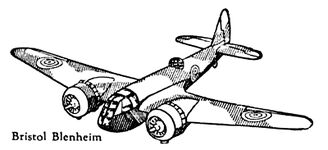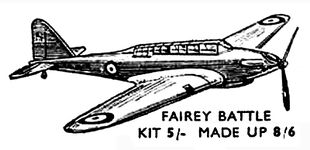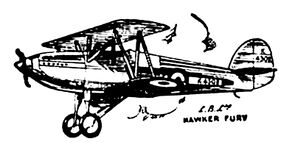Category:FROG Penguin Model Aircraft Kits
| Toy Brands and Manufacturers |
|---|
FROG Penguin Model Aircraft Kits |
| 1936 - |
January 1937: Launch advert, with three aeroplane kits [image info]
October 1937: Eight new kits, including Hangar [image info]
February 1939: Vickers Wellesley kit [image info]
March 1939: kit layout [image info]
International Model Aircraft's Penguin brand started out as a slightly confusing offshoot of IMA's flying model aircraft business. The Penguin aircraft range were the first 1:72 scale plastic model aircraft kits, and historically, they represent a link between the subsequent (and much more famous) 1:72 Airfix model aircraft kits, and the earlier 1:72 model (wooden) aircraft kit range made by Skybirds.
Origins
IMA had a flourishing business in the 1930s, making premium flying rubber-band-powered model aircraft, which they tested on the football field in the centre of Lines Brothers' Tri-ang Works in Merton, London. IMA's range was called FROG, which stood for "Flies Right Off Ground", and their logo was a winged frog. The brand used traditional materials and was promoted on the grounds of engineering excellence. Everything was (reasonably) simple, with the slight twist that they then started also making built-it-yourself kit flying aircraft.
According to the legend, they were having trouble with wooden propellers that broke along the grain whenever a plane had a rough landing, and decided to investigate the use of plastic "props". Since the parent company Tri-ang famously loathed buying in components from outside, and was seriously into the idea of vertical integration, self-sufficiency and making everything in-house, IMA found themselves toying with the idea of buying an injection moulding machine, just to make little plastic propellers. As this was rather extravagant, they started casting around for other ideas of aeroplane-based things that one could use an injection moulding machine for, and on investigating the 1:72 wooden model aircraft kits already made by Skybirds, started wondering if this was the sort of product that one could manufacture in plastic.
Penguin
The problem that IMA then had, as a company that previously only made flying kits and models, was how to start promoting kits and model aircraft that quite emphatically didn't fly. The solution they hit on was to create a sub-brand, "Penguin", named after a bird that didn't fly. Thus was born the brand "FROG Penguin".
From here, the Penguin brandname went in two directions: Triang started migrating some of their older metal toys to plastic, and using the Penguin name (perhaps using the IMA injection-moulding machine?), and FROG (Penguin), and then just FROG, increasingly became a post-war brandname associated with plastic kits of all kinds, including ships and cars.
The Penguin model aircraft range
Launched at the end of 1936, and first appearing in Meccano Magazine advertising in the January 1937 issue (which would probably have been available in late December 1936), the new Penguin range initially consisted of just three different aircraft, and slowly grew to perhaps 28 different versions in February 1940 (including colour variations), plus a Hangar kit and some aerodrome accessories. The models were available either as kits (suffixed "P" for "Penguin") or ready-built (suffixed "PM" for "Pre-Made").
November 1939 / February 1940 text and listing:
- Airspeed Envoy
- Armstrong Scimitar
- Avro 504 K
- Blackburn Shark
- Blackburn Shark Seaplane
- Blackburn Skua
- Bristol Blenheim
- D.H. Diana
- Empire Flying Boat
- Empire Flying Boat Deluxe
- Fairey Battle Camouflage
- Fairey Battle Silver
- Gloster Gladiator
- Hawker Demon
- Hawker Fury
- Hawker Hart with Gun
- Hawker Hind
- Hawker Hurricane
- Hawker Osprey
- Monospar Ambulance
- Percival Gull
- Rota Autogiro
- Service Envoy
- Short Singapore III Flying Boat
- Supermarine Spitfire
- Vickers Wellesley
- Vickers Wellington
- Westland Lysander
- Hangar Kit, etc.
Kit contents
Supplied complete with paint and glue in a silver-coloured box, Penguin kits borrowed the practice from Skybirds of using different materials to make some of the more awkward components, and, like Skybirds and the Meccano Aeroplane Constructor kits, had all the main parts carefully strung onto a card backing – plastic kits hadn't yet adopted the simplifying "Airfix" practice of having the parts attached to a sprue during moulding, and leaving them attached.
Although the early plastic used by Penguin was prone to warping, the Penguin kits were surprisingly stable, and for additional safety, some of the multi-part fuselage assemblies were glued together at the factory, to guarantee that they wouldn't have warped by the time the customer tried to build the rest of the kit.
The Singapore Flying Boat was particularly impressive, and was an exception to the rest of the range in that the hull was too big to safely produce by injection-moulding, and was instead supplied as a piece of shaped wood that needed further finishing by the modelmaker.
Wartime advertising
Pages in category ‘FROG Penguin Model Aircraft Kits’
The following 4 pages are in this category, out of 4 total.
Media in category ‘FROG Penguin Model Aircraft Kits’
The following 26 files are in this category, out of 26 total.
- Airspeed Envoy, FROG Penguin (MM 1937-10).jpg 1,600 × 829; 149 KB
- Armstrong Scimitar, FROG Penguin (MM 1937-10).jpg 1,600 × 1,108; 156 KB
- Avro 504E, FROG Penguin (MM 1937-10).jpg 1,600 × 663; 96 KB
- Blackburn Shark, FROG Penguin (MM 1937-10).jpg 1,600 × 683; 120 KB
- Bristol Blenheim, FROG Penguin (MM 1939-12).jpg 1,600 × 732; 118 KB
- Fairey Battle, FROG Penguin (MM 1939-02).jpg 1,600 × 775; 127 KB
- FROG Penguin (MM 1940-08).jpg 1,744 × 2,400; 855 KB
- FROG Penguin (MM 1940-10).jpg 1,764 × 2,400; 749 KB
- FROG Penguin Series (MM 1937-10).jpg 1,695 × 2,200; 521 KB
- FROG Penguin, blackout ad (MM 1940-01).jpg 1,796 × 2,400; 737 KB
- FROG Penguin, kit box layout (MM 1939-03).jpg 1,791 × 2,400; 666 KB
- FROG Penguin, leaflet (MM 1940-11).jpg 1,766 × 2,400; 761 KB
- FROG Penguin, new (1937-01).jpg 970 × 1,600; 272 KB
- FROG Penguin, New Models (MM 1939-12).jpg 1,917 × 2,400; 657 KB
- FROG Penguin, Vickers Wellesley (MM 1939-02).jpg 1,798 × 2,400; 724 KB
- Gloster Gladiator, FROG Penguin (MM 1937-10).jpg 1,564 × 1,062; 163 KB
- Hangar, FROG Penguin (MM 1937-10).jpg 1,600 × 767; 180 KB
- Hawker Fury, FROG Penguin (MM 1937-10).jpg 1,600 × 814; 128 KB
- Hawker Fury, FROG Penguin (MM 1939-12).jpg 1,600 × 776; 112 KB
- Hawker Osprey, FROG Penguin (MM 1939-12).jpg 1,600 × 1,068; 183 KB
- Monospar, FROG Penguin (MM 1939-12).jpg 1,600 × 1,036; 118 KB
- Percival Gull, FROG Penguin (MM 1937-10).jpg 1,600 × 651; 97 KB
- Rota Autogiro, FROG Penguin (MM 1939-02).jpg 1,600 × 867; 112 KB
- Vickers Supermarine Spitfire, FROG Penguin (MM 1939-12).jpg 1,600 × 1,285; 166 KB
- Vickers Wellesley, FROG Penguin (MM 1939-12).jpg 1,530 × 1,600; 157 KB
- Vickers Wellington, FROG Penguin (MM 1939-12).jpg 1,600 × 1,268; 182 KB





















































